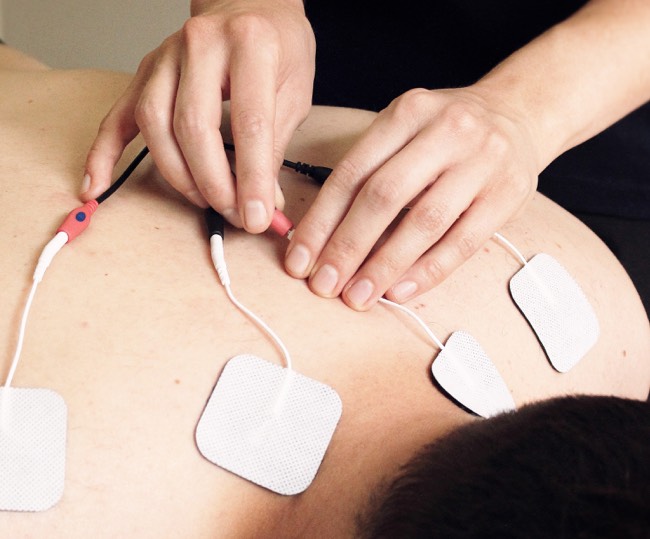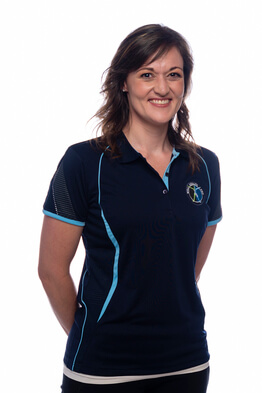Interferential therapy (IFT) is a non-invasive electrotherapy modality commonly used in physical therapy and rehabilitation. If you’ve ever been to a physiotherapist, you may know IFT as the machine that causes “tingles” over your skin. This modality is especially useful in acute pain or severe muscle spasm when the area is highly sensitive to pressure or touch. Interferential current is then used to desensitize the area, creating a window of pain relief for other techniques and treatment options.
Although interferential current therapy doesn’t have long term effects, it is a useful part of therapy for pain management, treating muscle spasm and promoting healing.
What exactly is interferential therapy?
The core principle behind interferential therapy is the interference of two high-frequency electrical waveforms to create a lower-frequency therapeutic waveform. This lower-frequency waveform can penetrate deeper into the tissues, making it effective for treating pain and muscle-related issues.
Why we use interferential current therapy
There are many factors that influence human skin’s resistance to current. This inherent resistance decreases when higher frequency waveforms are applied. Therefore, interferential therapy is more comfortable on your skin and can penetrate deeper into the tissue than other forms of electrotherapy. Using four electrodes also allows us to treat a larger area. The electrodes are positioned in such a way that the two high-frequency currents overlap over the target area. The resulting interference gives us a low-frequency, therapeutic waveform.
Benefits of interferential current therapy
- Pain management
- Muscle relaxation
- Increases blood flow
- Decreases inflammation
- Stimulation of nerves
- Promotes healing
“Where pain meets its match.”
The Technique
A specific electrotherapy machine is used to deliver interferential current therapy. These machines are very different from the small TENS units you can use at home. The electrodes are connected to the machine via two leads, or wires. Each lead has two ends that connect to one electrode each, completing the circuit.
The electrodes are applied to a clean, dry area, usually in a square or diamond shape with the electrodes from one lead diagonally across from each other. The currents from the two leads have to intersect over the target area.
Different frequencies are used for different conditions, depending on the treatment goals.
Different types of application
Pain Management: A frequency of 90-150Hz is used for pain relief.
Muscle activation and retraining: When indicated, interferential current is also used for muscle contraction. In this case, a frequency of 0-50Hz is applied.
Circulation: To improve blood flow to an area, a frequency of 0-100Hz is applied for vasodilatation.
Local effects of interferential current therapy
Pain Reduction
Lower frequency interferential current therapy stimulates the release of your body’s natural pain killers. On the other hand, higher frequencies are used for pain management by using the gate theory.
Increased Blood Flow
The electrical current increases blood flow in the target area, delivering more oxygen and nutrients to the tissues. This, in turn, promotes healing and reduces inflammation.
Muscle Relaxation
Increased blood flow to the affected muscles also reduces muscle tension and helps to improve flexibility.
Reduces swelling
Improved circulation doesn’t only improve bloody supply to the area, it also stimulates lymphatic drainage. The lymphatic system removes waste products and accumulated fluid, or swelling, from the treated area.
Nerve Stimulation
Interferential current is also used for its numbing effect and changes in pain perception, by stimulating neural structures in the injured area.
Improved Range of Motion
Pain causes muscle tension and inhibition, leading to stiffness and decreased range of motion. Interferential current helps to achieve muscle relaxation and pain relief, improving range of movement.
Cellular changes
Promotes Cell Repair and Regeneration
Interferential current is used to improve blood supply and oxygenation to the affected tissues. This promotes cellular repair and regeneration for healing and recovery.
Reduction in Edema
Swelling, or edema, causes cellular compression, disrupting the normal activity in cells. Interferential current enhances lymphatic drainage, helping to remove excess fluid from the tissue and reducing this compression.
Improved Cellular Communication
Another beneficial effect of electrical stimulation, is that it modulates cellular communication and signaling pathways. This modulation is useful when we want to alter pain perception and promote tissue healing.
Neuroplasticity
Neuroplasticity is your brain’s ability to reorganize and adapt to changes in the environment. In cases involving nerve conditions or injuries, interferential current can be used to stimulate the nerve cells to promote this adaption.
Interferential current therapy feels like
The application of interferential current therapy should never be painful. At first, you will only feel the cold electrodes. Your physiotherapist will gradually increase the intensity of the current. In most cases, you will feel a mild to moderate tingling sensation or a rhythmic pulsing. You may also experience slight itchiness or prickling due to stimulation of nerve endings.
If interferential therapy is used for muscle activation and retraining, you will feel mild muscle contractions or twitches.
How long does Interferential therapy take?
The duration of interferential therapy during a session will vary depending on your problem and the treatment goals determined by your physiotherapist. In general, application time is between 10-20 minutes.
How many times should I get interferential current treatment?
Interferential current therapy is never used in isolation, but rather as part of the bigger picture in your treatment. In the acute stage, when you have significant pain, interferential treatment could be used during every session. As you heal, pain isn’t the the dominant factor anymore, so the treatment goals will change. At that point, interferential therapy could still be used for muscle relaxation or be stopped altogether.
After making a diagnosis and getting a full understanding of your problem, your physiotherapist will discuss a treatment plan with you. Then we can give you an idea of how long it will take for your condition to improve and how often treatment is needed. In some cases, like after shoulder surgery, we’ll need to see you over a period of 8-12 weeks. Other cases need 6-8 sessions over a 6 weeks. Mostly you will need two sessions within the first week of starting treatment, then once a week for two weeks and once every second week in the next month thereafter.
What can I do at home to ensure interferential therapy is effective?
Firstly, an important part of a successful treatment plan lies in what you do at home in between sessions. Follow your physiotherapist’s instructions about the do’s and don’ts for your injury. If you are unsure about something, make a mental note to ask your treating medical professional at your next appointment.
Secondly, consistency is key. Don’t get impatient if you feel that your progress is too slow! Stick to the treatment schedule and do your home exercises as prescribed.
There are also some pain management techniques you can use at home, like applying heat therapy or ice. Ask your physiotherapist which one will be most effective for your problem.
Cost of interferential current therapy
There is a specific medical aid rate for interferential current as treatment. However, electrical stimulation forms one part of the treatment plan. This means you will never be paying for only interferential current.
Although electrical stimulation is a useful part of treatment, it won’t fix your problem on its own. The complete treatment package will get you real results.
Medical Aid Code – 107
The interferential current treatment code 107 is used for interferential therapy. However, it can be applied at the same time as other techniques and modalities. Most good medical aids offer re-imbursement for interferential current treatment.
Does it make a difference to have an experienced physiotherapist apply interferential current?
Yes, having an experienced physiotherapist or healthcare professional apply interferential therapy makes a significant difference in terms of safety and effectiveness.
A physiotherapist is expertly trained in gathering information from what we hear and see, putting all this information together and making an accurate diagnosis. In fact, knowing whether the problem is muscle-, nerve- or joint-related will determine the correct placement and parameters for interferential current therapy.
Our medical professionals have a thorough understanding of anatomy, pathology, healing and rehabilitation from years of training and experience. Combining this wealth of knowledge, that includes contraindications and special considerations for the use of interferential therapy, we can also select and apply the correct modalities for your specific condition.





